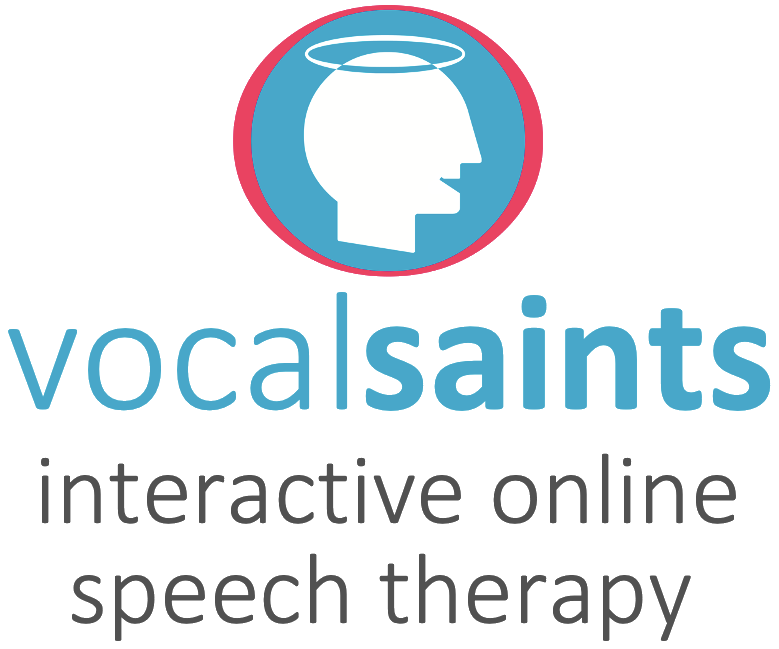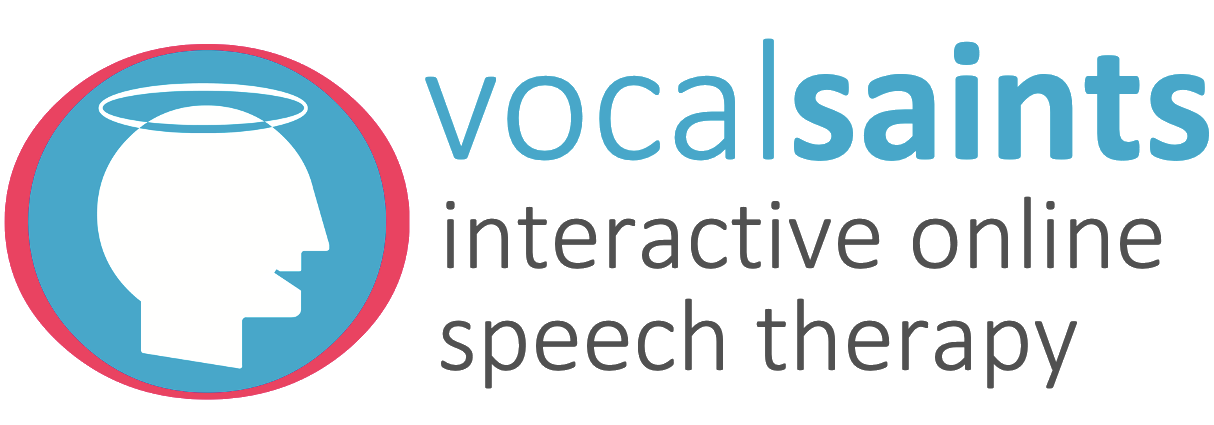

Frequently Asked Questions
Speech and language therapy at Vocalsaints supports people of all ages with a wide range of communication concerns. Teletherapy is one way that this support is provided. Teletherapy is live, in real time, using both visual and audio. It is engaging and interactive therapy where the Therapist and family connect via a device, often a computer but a tablet also works. Like physically-in-person therapy, appointments are individualised and tailored to the person’s communication needs and interests. Results of teletherapy are found to be the same as physically-in-person therapy. This video shows some examples of what teletherapy can look like for children.
The short answer is “it always works, but for some people more than others”. Speech-language therapy is an individualised service, which aims to help you or your loved one’s communication skills progress from where they are currently. It has made a significant difference for a number of families and everyone can benefit from speech-language therapy to some degree.
However, if there is an on-going physiological disorder present such as hearing loss or cleft palate, speech-language therapy services may only minimise communication difficulties – not eliminate them entirely. Augmentative and alternative communication may be appropriate in these cases, which speech and language therapy can support. No matter what the underlying issues are, Vocalsaints will always provide professional and research-based practice, and investigate different therapy options based on best clinical judgement.
While this is a difficult question to answer, in a general sense the following are categories that often involved:
Genetic – there’s a family history.
Medical causes, including hearing loss and chronic ear infections. Premature birth.
Characteristics as part of a syndrome other on-going medical disorder.
Brain injury: before, during, or after birth. General lack of the stimulus to learn language.
And sometimes there may be no known cause for a person’s communication disorder.
Speech-language therapy treats what is known – the presenting and underlying difficulties.
Speech involves the sounds to make up words, e.g. “d”, “g”, “s”. It is the physical formation of sounds and the sequencing of these sounds to say a word, e.g. “d—o—g” makes the word “dog”. Speech difficulties can involve deletion, substitution, or physical inability to form sounds.
Language is divided into two areas: comprehension and expression. Comprehension is the act of understanding the verbal and non-verbal communication that another person provides to us; this involves attention, listening, and mental processing skills. Expression is the aspect of language that we generate – it is what we say. Expressive language involves words, syntax (word order) and our use of grammar, for example saying “cats” means “more than one of them”. For some people, "expression" comes in the form of sign, picture or high-tech device.
Note that there is an aspect of talking that is related to fluency, in which someone may, for example, have difficulty talking smoothly and easily. You may wish to refer to our “stuttering” section for further information on fluency.
The difficulty with ‘wait and see’ is the unknown of whether this is all that is required or not. How long are you prepared to wait to see whether or not your loved one will make the necessary progress to catch up to their peers? What if ‘wait and see’ means that your loved one is now even further behind because of the missed time waiting? For peace of mind, get the advice and guidance of a qualified Speech Language Therapist.
Starting early does not lock you in to any kind of therapy. By starting early, you will be helping your loved one and easing your mind.
Therapy can start from as young as 16 months of age. For very young children who have no-to- little language, their therapy is different to someone who is older and can work directly with a Therapist. Often the best way to start developing a young child’s language is through a family member/parent who can implement strategies and techniques throughout the child’s day.
Therapy for this group is done through modelling, guiding and upskilling key adults with specific language-enriching techniques. By starting therapy at a younger age you are giving your child the best start and reducing frustration by them not having their needs understood or met. For a number of families, by starting with their child very young, they have been able to get the individualised support as the correct underlying difficulties were identified and appropriate treatment could begin early.
The speech-language therapy process may require a small handful of sessions, or need frequent sessions for over a year. A useful estimate for children’s treatment is around eight to twelve once-weekly sessions, as this has been a common duration historically. Bear in mind that there are several factors affecting the overall duration of treatment. In addition to cost, the overall treatment duration is also affected by the frequency of therapy, the severity of presenting communication difficulties and the intensity/consistency of home support. Support and practice time at home is important, because if more is done there, overall progress will be faster and treatment techniques will take less time to generalise into daily language.
Vocalsaints attempts to cater for a range of different needs by offering various types of services: These range from one-off discussion and guidance sessions, to home programmes, to one-on-one therapy. With all types of treatment, parents are kept well informed and the regularity of appointments is always in discussion with the parent/caregiver.
When supporting individuals with more severe communication disorders, allowing a slightly longer treatment duration will deliver several benefits. Firstly, it will allow time for consolidation of their therapy targets, and integration into everyday conversation. A second benefit comes in the advocacy an SLT provides for children in their schooling. Many schools may not have the special education infrastructure or funding to fully understand a child’s communication needs and help them continue the academic process. In this case, an SLT can help by:
Contributing to Individual Education Plan (IEP) meetings; Liaising with Teachers’ Aides; and Recommending a range of other in-class strategies to help a child receive the very most out of their schooling.
Professional knowledge and experience tailoring what is required to make a positive difference in the areas of communication concern. Speech-language therapy is science! The strategies and techniques used in speech-language therapy are evidence-based, derived from research and/or years and year and years of experience working alongside children, adults and their families.
Typically, a therapy session involves a Therapist working directly with the individual. For children this is usually within a game, which is either the specific therapy target or as a motivator. Some older children and young adults also play therapeutic games! This is followed by an explanation to the parent/caregiver regarding what was worked on, how the individual progressed and how they can be supported at home to continue consolidating their target. For children and adults in therapy, each family is provided with the information and resources to do home-based reinforcement.
In the New Zealand context, private means that the ‘user’ pays for the service. While there is still a code of ethics that all Therapists need to follow, there are often no set restrictions for accessing a private service. This is significant for those who are not New Zealand residents and are unable to access publicly funded services. Also for those who do not want to wait until a place has become available.
All Speech-Language Therapists – public or private – have the specialised training, skills and experience to assess and treat an individual’s communication difficulties. In New Zealand, speech-language therapy services can be accessed through several sources:
- Through private practitioners such as Vocalsaints, you can receive help almost immediately, but a fee is charged for their services. Private therapy is focused, specific and tailored direct hands-on therapy with a qualified Speech Language Therapist. Generally there is less movement of Therapists in private practice, therefore it can often a higher continuity of care.
- Publicly, through the Ministry of Education (MoE). Public speech-language therapy is free, but has strictly limited acceptance criteria based on a child’s age (3-8 years) and the severity of their communication disorder (moderate-severe). Public speech therapy entails a waiting list which varies between cities but can range from six to twelve months long. Public therapy is more consultation and guidance with ups-killing to Teachers and parents on how they can support the child themselves.
- Through hospitals, who may provide a Speech-Language Therapist free of charge and with little-to-no waiting list, if communication disorders have arisen due to an accident or medical issue, or under 2 years of age.
Private and public practitioners can often collaborate to provide support, with clients starting private therapy while on the waiting list for MoE services. Private Speech-Language Therapists then transfer their client’s treatment notes across to public therapists when they become available.
Some families request that public and private therapists work together, as there can be two areas of difficulty that can be treated at once. In this case, each Therapist would see the client separately.
The first appointment is for finding out information about the person in question – you, your child or older loved one. This can be through discussion with you (the caregiver or family member), as well as formal and/or informal testing, which can involve observation of the child playing or interacting with you and maybe his/her peers. From here, areas in need of support are identified, goals are set up and specific therapy can start as required. These will be discussed with you.
Therapy appointments are goal-focussed, informative and engaging. Especially for children, appointments are fun and full of therapeutic games.
Firstly, consider the long-term cost of money, time, frustration and disappointment if the communication concern isn’t rectified at a young age. Even little delays at a young age can turn into much bigger delays or gaps to peers.
The financial investment is dependent on what is required. For some individuals "advice, guidance and monitoring" is enough to support age-appropriate development. For others it is a longer journey. For those experiencing moderate difficulties, many would require 6-12 months of specialist input to achieve their targeted goals. It is best to speak with a Speech Language Therapist to gain a clearer idea of what is required. There are different therapeutic options available which can be discussed at this first appointment.
To get an idea of what kind of costs might be involved, please go to our booking page which has our current prices. You do not need to book an appointment before seeing these details.

